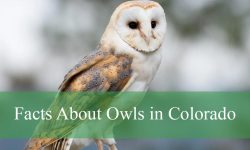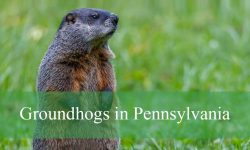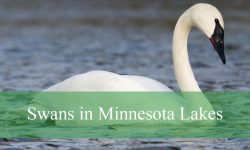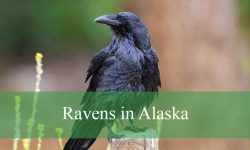The wildlife in Texas is incredibly varied, and the many geese species that live or migrate here are some of the most interesting birds to observe. From the familiar Canada Goose to rare visitors like the Red-breasted Goose, Texas offers diverse habitats that support these graceful waterfowl. Learning to identify these geese can deepen your appreciation of Texas’s natural beauty and the ecosystems they inhabit.
This article explores 12 species of geese commonly found in Texas, complete with photos and detailed identification tips. You will learn how to distinguish them by size, coloring, behaviors, and calls. Additionally, interesting facts about each species and insights into their habits and migration patterns will help you understand these birds better as they grace Texas skies and waters throughout the year.
Common Geese You Can See in Texas
Canada Goose (Branta canadensis)
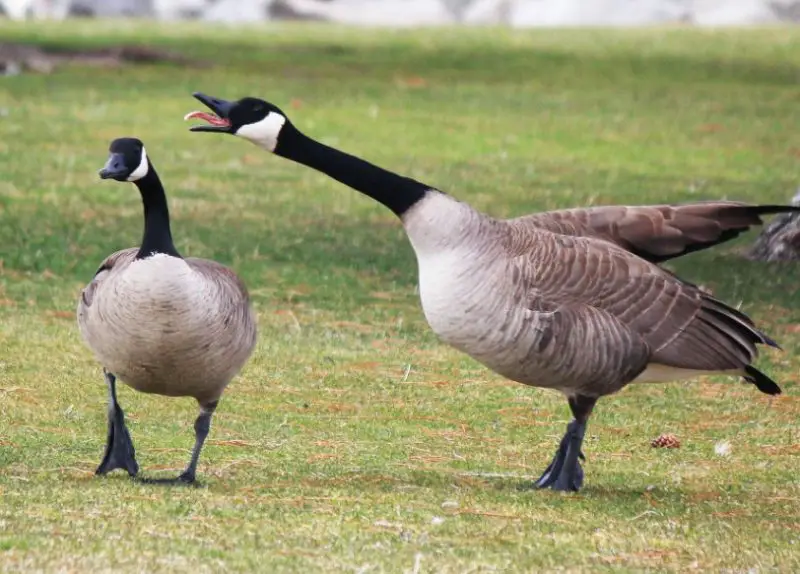
The Canada Goose is one of the most recognizable and widespread waterfowl species found in Texas. Characterized by its long black neck and head with a distinctive white chinstrap, this bird stands out among other geese. Its body is mostly brown with a lighter chest and belly, and it has large webbed feet that help in swimming efficiently. Adults typically measure between 30 to 43 inches in length, with a wingspan reaching up to 6 feet, making them quite impressive in size.
Identification of Canada Geese is fairly straightforward due to their unique coloration and size. Their honking calls are loud and carry over long distances, which is often how people first become aware of their presence. Canada Geese are highly adaptable and can be seen in a variety of environments from city parks and golf courses to lakes, rivers, and coastal marshes. In Texas, they are commonly found statewide throughout the year, though some populations migrate seasonally.
Behaviorally, Canada Geese are known for their strong family bonds and social structure. They travel in flocks and migrate in the famous V-shaped formations. Their diet mainly consists of grasses, grains, and aquatic plants, which they graze on land or forage underwater. These geese are also known for their territorial nature during nesting season, often aggressively defending their nests and goslings.
A fun fact about Canada Geese is their remarkable navigational ability during migration. They can travel thousands of miles and often return to the exact nesting sites year after year. In Texas, they are a favorite sight in urban and rural settings alike, where their loud calls and graceful flight make them unmistakable symbols of the wild.
Snow Goose (Anser caerulescens)
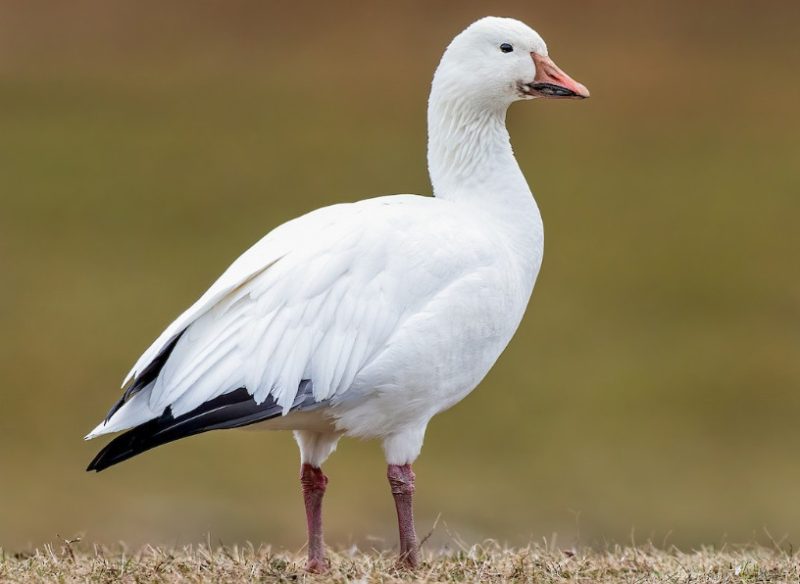
The Snow Goose is a striking species famous for its pure white plumage contrasted by black wingtips that become visible during flight. Some individuals exhibit a “blue morph” with a grayish body and white head, adding to their visual diversity. Adults measure approximately 25 to 33 inches long with a wingspan of around 50 to 65 inches. Their relatively compact size compared to Canada Geese makes them agile flyers during long migrations.
Snow Geese are typically identified by their bright white feathers and stout orange bill, which features a distinctive “grinning patch” of black along the sides. Their vocalizations are high-pitched and often described as honking or cackling. These geese frequent open wetlands, agricultural fields, and shallow lakes in Texas during the winter months, where they forage in large flocks.
In terms of behavior, Snow Geese are highly gregarious, forming massive flocks that can number in the tens of thousands. They feed primarily on roots, tubers, grasses, and grains, often gleaning leftover crops from harvested fields. Their presence in Texas is most notable during winter migration, as they stop to rest and refuel on their way to and from Arctic breeding grounds.
A fascinating fact about Snow Geese is their incredible flock size, which can sometimes darken the sky during mass flights. This spectacle is a favorite among bird watchers and photographers in Texas and beyond. Despite their peaceful appearance, Snow Geese can be quite aggressive when protecting their nests during breeding season.
Ross’s Goose (Anser rossii)
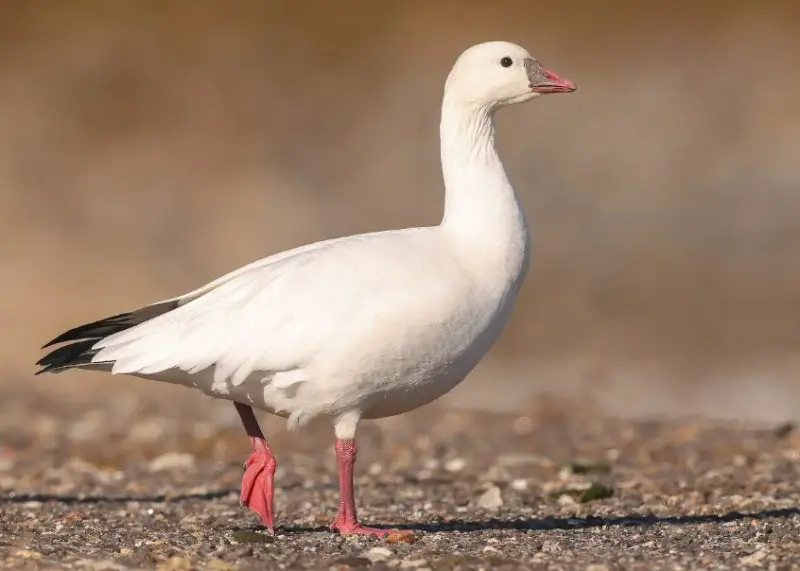
Ross’s Goose is one of the smaller members of the goose family, easily distinguishable by its compact size and pure white plumage. Adults typically measure 23 to 27 inches in length with a wingspan of about 45 to 55 inches. Their short neck and stubby orange bill give them a distinct, cute appearance compared to other geese. They are often found in flocks alongside Snow Geese during migration and winter in Texas.
Identifying Ross’s Goose can be challenging due to its similarity to the smaller Snow Goose, but key features include its smaller size, shorter bill, and a more rounded head shape. Their calls are higher-pitched and less raucous than Snow Geese. In Texas, Ross’s Geese frequent wetlands, agricultural fields, and open water bodies during winter, feeding in mixed flocks with other waterfowl.
The behavior of Ross’s Goose aligns closely with Snow Geese; they are social, forming large flocks and feeding on grasses, sedges, and agricultural crops. They are migratory, arriving in Texas in late fall and leaving by early spring. Their ability to thrive in harsh Arctic breeding grounds speaks to their resilience and adaptability.
An interesting fun fact about Ross’s Goose is that its population experienced a significant decline in the past but has rebounded due to conservation efforts. Bird watchers in Texas often enjoy spotting them during migration, appreciating their delicate size and subtle differences from their Snow Goose cousins.
Greater White-fronted Goose (Anser albifrons)
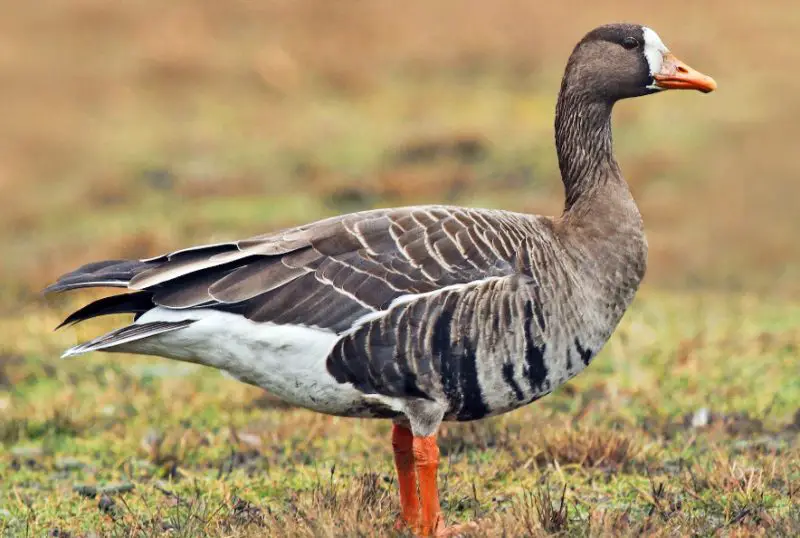
The Greater White-fronted Goose is named for the prominent white patch at the base of its bill, which contrasts with its generally brownish-gray body. Adults measure around 26 to 30 inches in length, with a wingspan of approximately 50 to 65 inches. They have orange legs and a pinkish bill, along with black barring on their belly that distinguishes them from other geese.
These geese are relatively easy to identify thanks to their distinctive white face patch and barred underparts. Their vocalizations are loud and honking, often heard when they are in flight or gathered in flocks. In Texas, the Greater White-fronted Goose is typically a winter visitor found in agricultural fields, wetlands, and marshy areas where they feed and rest.
Behaviorally, this species prefers open habitats where they can graze on grasses, seeds, and agricultural grains. They often feed by dabbling in shallow water or grazing on land and are usually found in small to medium-sized flocks. Their migratory patterns bring them to Texas mainly during the colder months as they travel between northern breeding grounds and southern wintering areas.
A fun fact about the Greater White-fronted Goose is their remarkable adaptability to various habitats, from tundra to farmlands. They are sometimes referred to as “specklebelly” due to the black spots on their belly feathers, a helpful nickname among birders in Texas.
Brant (Branta bernicla)
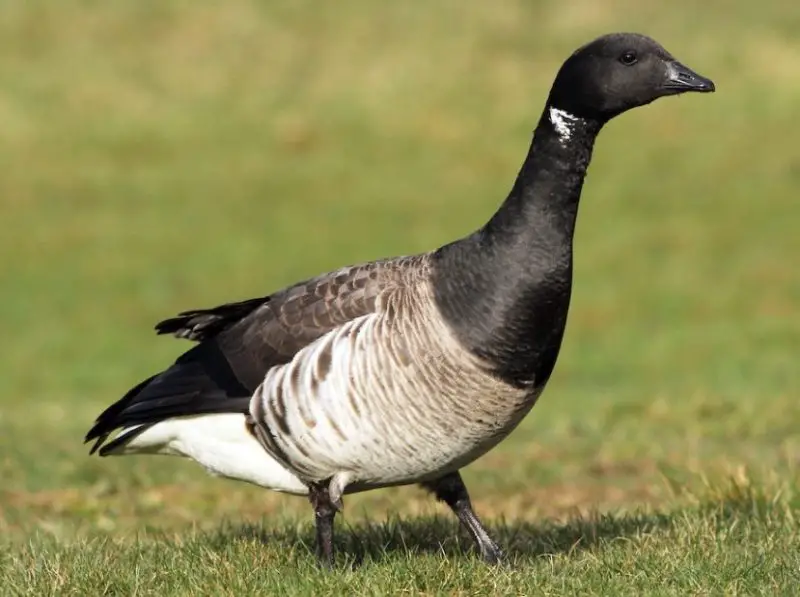
The Brant is a smaller, coastal species of goose with a predominantly dark, almost black body and a contrasting white patch on its neck. Adults range from 23 to 27 inches long with a wingspan near 42 to 46 inches. Its compact size and unique coloring make it stand out among the more common gray and white geese in Texas.
Identification of the Brant is relatively simple because of its mostly black plumage and distinctive white neck patch, which sometimes extends onto the face. Their calls are soft and low-pitched, differing from the louder honks of other geese. Brants are typically found in coastal and estuarine environments in Texas, particularly during winter migration.
Behaviorally, Brants feed mainly on eelgrass and other marine vegetation found in shallow coastal waters. They tend to form small flocks and can often be seen resting on beaches or shallow bays. Their presence in Texas is mostly seasonal, as they breed in the high Arctic and migrate southward to coastal regions.
An interesting fact about the Brant is its reliance on coastal habitats, making it vulnerable to changes in sea level and pollution. Bird watchers in Texas enjoy spotting this rare goose species during migration periods along the Gulf Coast.
Cackling Goose (Branta hutchinsii)
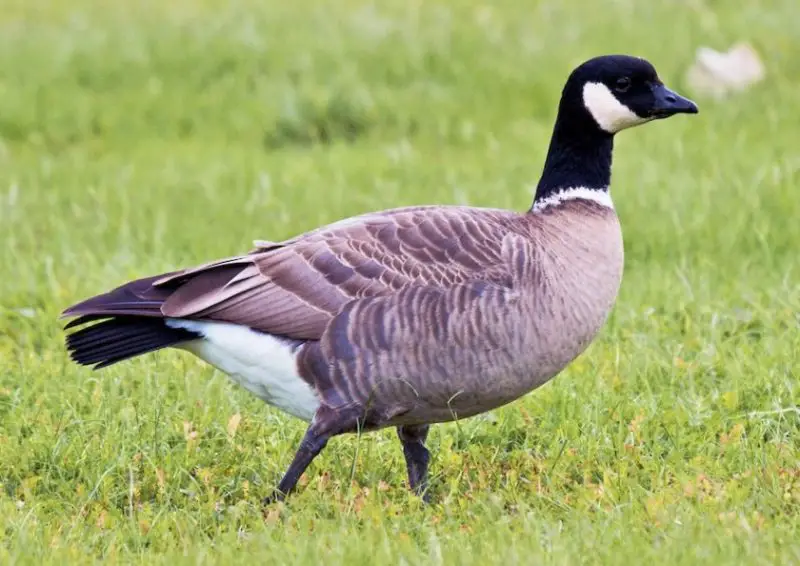
The Cackling Goose is a smaller relative of the Canada Goose, distinguished primarily by its more compact size and shorter neck. Adult Cackling Geese range from 20 to 26 inches in length with a wingspan between 39 and 46 inches. They have a similar black head and neck with a white chinstrap, but their smaller stature and often stubbier bill help differentiate them from their larger cousins.
Identification of the Cackling Goose can be tricky because it closely resembles the Canada Goose. However, their smaller body size, shorter neck, and higher-pitched, cackling calls are key distinguishing factors. In Texas, they are mostly observed during migration periods and winter months, frequenting similar habitats such as ponds, lakes, and wetlands.
Behaviorally, Cackling Geese tend to gather in flocks, often mixed with Canada Geese and other waterfowl species. Their diet primarily consists of grasses, sedges, and grains, which they forage both in water and on land. These birds are highly adaptable and can be found in rural agricultural fields as well as urban parks across Texas during colder months.
A fun fact about the Cackling Goose is that it was once considered a subspecies of the Canada Goose until recent genetic studies confirmed its distinct status. Birdwatchers in Texas enjoy spotting this smaller goose, often noting its more vocal and lively nature compared to the Canada Goose.
Barnacle Goose (Branta leucopsis)
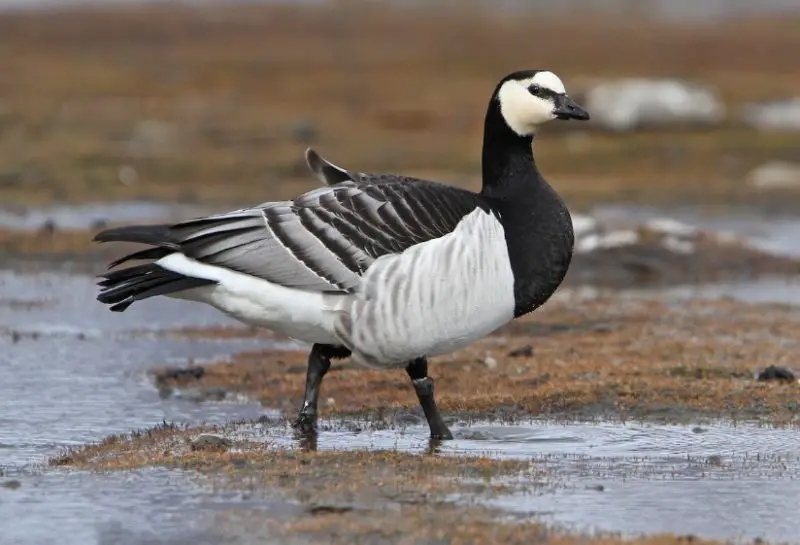
The Barnacle Goose is a striking black-and-white goose, featuring a predominantly black neck and chest with a white face and belly. Adults measure around 23 to 28 inches long, with a wingspan of about 43 to 50 inches. Its bold plumage makes it one of the most visually distinct geese seen in Texas, although it remains a rare visitor.
Identification is straightforward due to the Barnacle Goose’s unique coloration, which contrasts sharply with most other geese in the region. They have a distinct white face and forehead patch, with black legs and feet. Their calls are softer and less frequent than other geese, adding to their somewhat elusive presence in the wild.
Barnacle Geese are generally seen in coastal marshes, estuaries, and occasionally inland lakes during migration. Their diet consists mainly of grasses, sedges, and aquatic plants, which they graze upon in flocks. In Texas, they are rare but have been recorded as vagrants, mostly during the winter season.
A fun fact about the Barnacle Goose is its interesting migratory history; it was once mistakenly believed to hatch from barnacles, which led to its unusual name. This myth originated in medieval Europe and reflects the fascination people had with this unique bird.
Egyptian Goose (Alopochen aegyptiaca)
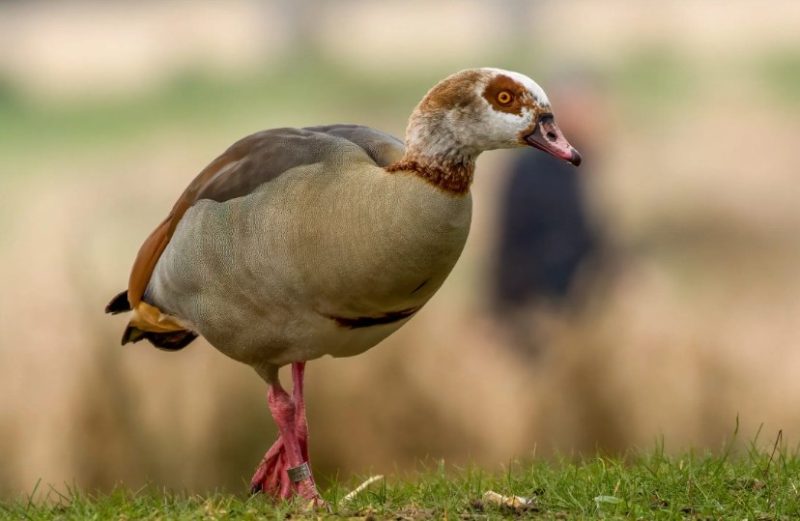
The Egyptian Goose is a colorful species native to Africa but has established feral populations in Texas due to escapes from captivity. Adult Egyptian Geese measure approximately 24 to 28 inches in length, with a wingspan reaching around 47 to 55 inches. They have striking plumage with a mixture of browns, whites, and rust colors, along with distinctive dark eye patches.
Identifying the Egyptian Goose is relatively easy because of its vivid coloration and the dark “spectacles” around its eyes. Its bill is pink with a dark tip, and its legs and feet are bright pink as well. These geese tend to be more solitary or found in small groups compared to other flocking species.
Behaviorally, Egyptian Geese are adaptable and often inhabit lakes, ponds, and urban waterways in Texas where they have been introduced. They feed on grasses, seeds, and small aquatic creatures, displaying opportunistic feeding habits. Though not native, they have adapted well to local conditions and can sometimes compete with native waterfowl for resources.
A fun fact about the Egyptian Goose is its historical significance in ancient Egypt, where it was often depicted in art and considered sacred. Its bold appearance and unique calls make it a fascinating species for birdwatchers in Texas who encounter it.
Emperor Goose (Anser canagicus)
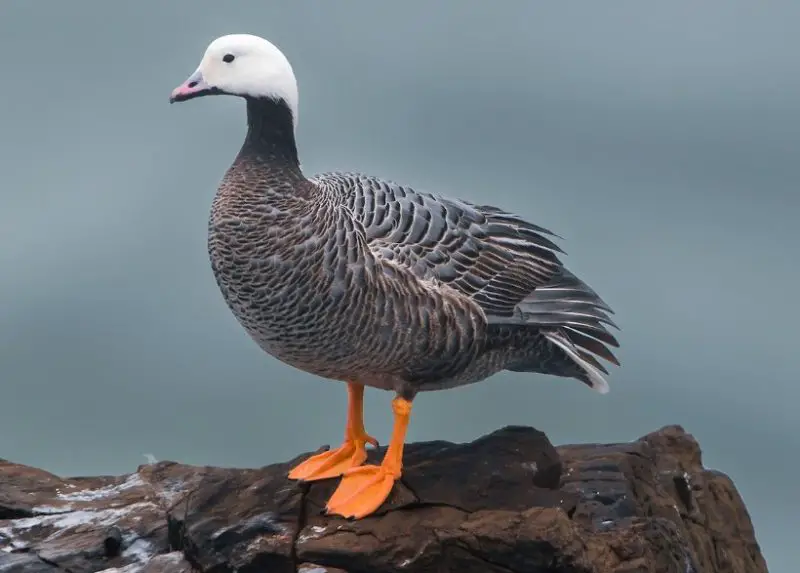
The Emperor Goose is a medium-sized waterfowl species with a striking coat pattern consisting of gray body feathers, white head and neck, and black markings on the neck and back. Adults measure between 23 to 26 inches in length, with a wingspan of about 44 to 50 inches. They are rare visitors to Texas, primarily during migration from their Arctic breeding grounds.
Identification of the Emperor Goose hinges on its unique plumage, which differs from other geese through the contrast of white and gray with black accents. Their bill is stubby and dark, and they emit a variety of calls that sound more like honks or whistles. Due to their limited presence in Texas, spotting an Emperor Goose is a treat for bird enthusiasts.
These geese typically inhabit coastal tundra, marshes, and estuaries where they feed on marine vegetation, grasses, and roots. They are strong swimmers and divers, which aids them in foraging underwater. Their migratory path brings them through parts of Texas mainly in the winter months, although sightings are infrequent.
A fun fact about the Emperor Goose is that its population remains relatively small compared to other North American geese, making it a conservation concern. Birders in Texas who encounter this species often cherish the rare glimpse of this Arctic migrant.
Aleutian Canada Goose (Branta canadensis leucopareia)
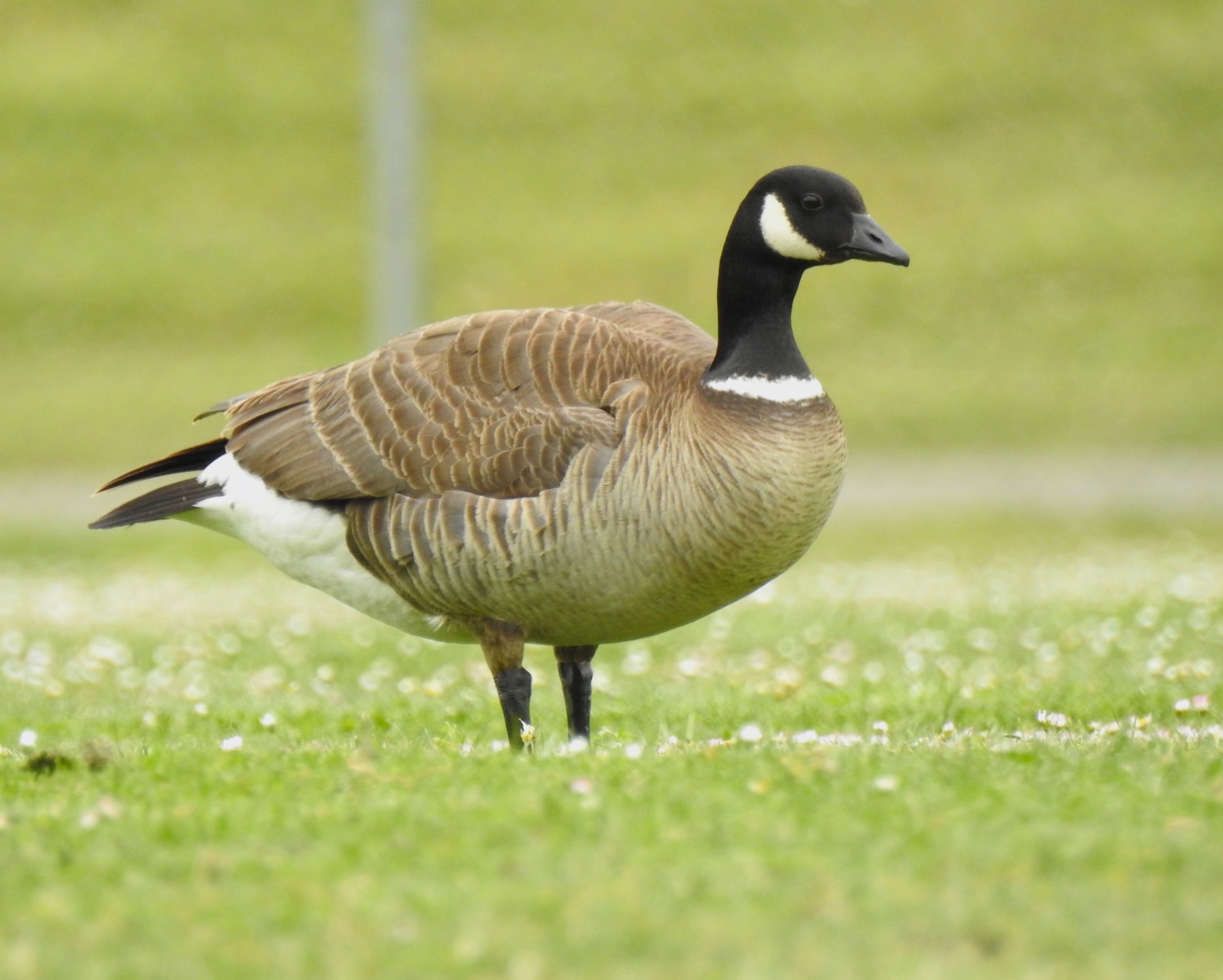
The Aleutian Canada Goose is a subspecies of the Canada Goose known for its slightly smaller size and paler plumage. Adults typically range from 26 to 32 inches in length, with wingspans reaching up to 54 inches. They have the classic black head and neck with a white chinstrap, but their bodies tend to be lighter in color compared to other Canada Geese.
Identification is aided by their geographic range and paler feathering, which distinguishes them from other Canada Goose subspecies. The Aleutian Canada Goose migrates from the Aleutian Islands in Alaska down to the southern United States, including parts of Texas during winter.
Behaviorally, these geese exhibit the same social traits as other Canada Geese, traveling in flocks, grazing on grasses, grains, and aquatic vegetation. They tend to prefer open water and wetland habitats but are also seen in agricultural fields during migration. Their presence in Texas is mostly seasonal, arriving in winter.
A fun fact about the Aleutian Canada Goose is that it was once considered endangered due to habitat loss and hunting but has since made a significant recovery thanks to conservation efforts. Spotting this subspecies in Texas offers birders a glimpse into the diversity within the Canada Goose family.
Red-breasted Goose (Branta ruficollis)

The Red-breasted Goose is a small, strikingly colorful species that stands out due to its vivid chestnut-red breast and face markings contrasted with black and white patches on its body. Adults typically measure around 22 to 25 inches in length with a wingspan of approximately 40 to 45 inches. Its compact size and bold coloration make it one of the most visually distinctive geese, though it is a rare visitor in Texas.
Identification of the Red-breasted Goose is relatively straightforward thanks to its unique red, black, and white plumage pattern. They emit soft, high-pitched calls that differ from the louder honks of larger geese species. In Texas, they are considered vagrants, meaning sightings are uncommon and typically occur during migration seasons.
Behaviorally, this goose tends to form small flocks and feeds mainly on grasses, leaves, and seeds found in tundra and marsh habitats. Their migratory routes take them from their Arctic breeding grounds to wintering areas in Europe and occasionally North America, including rare visits to Texas coastal wetlands.
A fun fact about the Red-breasted Goose is its highly social nature during the breeding season, where it often nests in close proximity to peregrine falcons for protection against predators. This fascinating mutualistic relationship is one of nature’s unique survival strategies.
Blue-winged Teal (Anas discors)
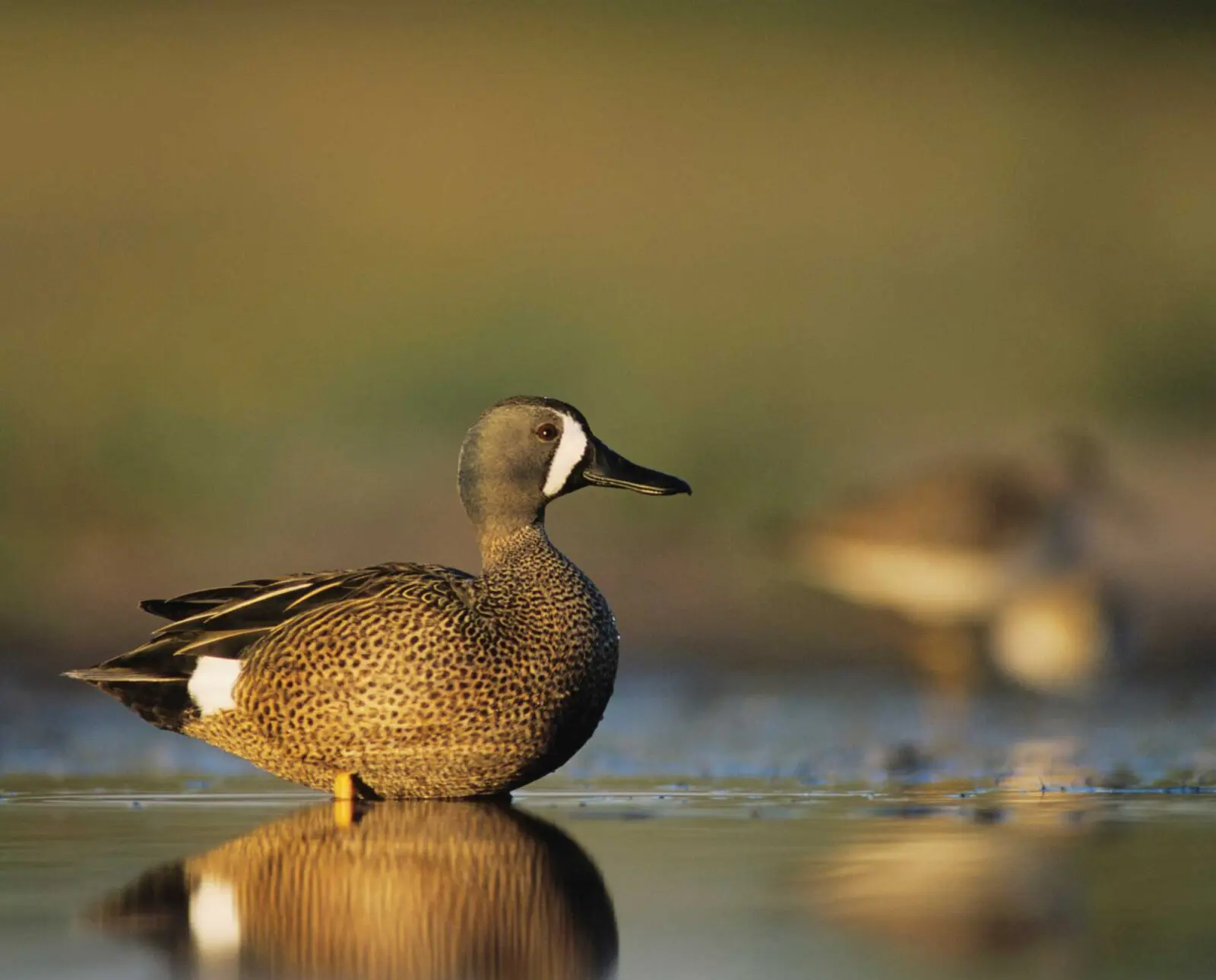
Although technically a species of duck rather than a goose, the Blue-winged Teal is often noted alongside geese due to its size and migratory habits. Adult Blue-winged Teals measure about 14 to 16 inches in length with a wingspan of 23 to 26 inches. They are among the smallest dabbling ducks in Texas, but their striking blue wing patches are easily visible in flight.
Identification of the Blue-winged Teal is characterized by its distinctive powder-blue wing coverts visible during flight and the male’s white facial crescent near the eye during breeding season. Their high-pitched whistles and rapid wing beats set them apart from larger waterfowl. They are abundant migrants in Texas wetlands and open water bodies during spring and fall.
Behaviorally, Blue-winged Teals are fast and agile flyers, often found feeding in shallow freshwater habitats on seeds, aquatic plants, and small invertebrates. Their ability to adapt to a range of wetland types makes them one of the most widespread migratory ducks in Texas.
A fun fact about the Blue-winged Teal is that it is among the earliest migratory ducks to arrive in Texas each spring, signaling the start of the waterfowl season. Their rapid wing beats and distinctive calls are favorite features among birdwatchers.
FAQs About Geese in Texas
What are the most common species of geese found in Texas?
The most common geese in Texas include Canada Goose, Snow Goose, Ross’s Goose, Greater White-fronted Goose, and Brant, among others.
When do geese typically migrate through Texas?
Most geese migrate through Texas during the fall and spring seasons, with many species spending the winter months in the state.
Where can I usually spot geese in Texas?
Geese can be found in a variety of habitats including lakes, rivers, wetlands, agricultural fields, and coastal marshes throughout Texas.
What do geese eat in Texas?
Geese primarily feed on grasses, grains, seeds, aquatic plants, and sometimes small invertebrates depending on the species and habitat.
Are any of the geese species in Texas considered endangered?
While most geese species in Texas have stable populations, some subspecies like the Aleutian Canada Goose have faced conservation challenges but have shown recovery.


